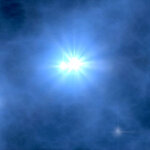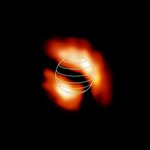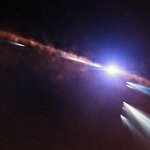Space

The expanding thermonuclear fireball of a nova is a staple of movies and fiction but last year one was witnessed in the constellation Delphinus with unprecedented clarity. The observations produced the first images of a nova during the early fireball stage and revealed how the structure of the ejected material evolves as the gas expands and cools.
On Aug. 14, 2013, Japanese amateur astronomer Koichi Itagaki discovered a "new" star that was subsequently named Nova Delphinus 2013. A nova occurs following the buildup of a thin layer of hydrogen on the surface of a white dwarf, a highly…

Get ready for a very close encounter as a house-sized asteroid 2014 UF56 will pass between the Earth and the Moon on Monday. The 15 meter wide space rock will miss our planet at a distance of about 160,000 km (0.4 lunar distances) at 9:12 p.m. UTC. The asteroid was discovered Saturday and despite passing so close to Earth, few if any of us will see the flyby with our eyes in a telescope. At brightest, 2014 UF56 will only reach magnitude +16, as it zips from Scutum constellation through Capricornus.
The asteroid, back in 2012 visited Mars at a distance of about 8 mln km. It will again…

On Oct. 25, 2014, the sun emitted its fifth substantial flare since Oct. 19. This flare was classified as an X1-class flare and it was a long duration event, beginning at 12:55 pm EDT, peaking at 1:08 pm and ending at 2:11 pm. Giant sunspot AR2192 is growing again, which means high solar activity is unlikely to subside this weekend. NOAA forecasters estimate an 85% chance of M-class flares and a 45% chance of X-flares during the next 24 hours. On Friday, the sun also emitted a significant solar flare, peaking at 5:41 p.m. EDT on Oct. 24, 2014. This flare is classified as an X3.1-class flare…

A new paper suggests that planets from the remnants of the universe's earliest stars could have supported life on dim, warm planets. Credit: NASA/WMAP Science Team
By: Ker Than, Inside Science
(Inside Science) -- Life in the universe could be much older than previously thought, forming as early as fifteen million years after the Big Bang, according to a provocative new idea proposed by a Harvard astrophysicist.
In this scenario for the early universe, rocky planets born from the dregs of massive, primordial stars would have been warmed by the heat of a radiation that permeated all of space,…

While studying the atmosphere on Saturn's moon Titan, scientists discovered intriguing zones of organic molecules unexpectedly shifted away from its north and south poles. These misaligned features seem to defy conventional thinking about Titan's windy atmosphere, which should quickly smear out such off-axis concentrations.
"This is an unexpected and potentially groundbreaking discovery," said Martin Cordiner, an astrochemist working at NASA's Goddard Space Flight Center in Greenbelt, Maryland, and the lead author of a study published online today in the Astrophysical Journal Letters. "These…

Beta Pictoris is a young star, only about 20 million years old, located about 63 light-years from us. It is surrounded by a huge disc of material, a very active young planetary system where gas and dust are produced by the evaporation of comets and the collisions of asteroids.
Flavien Kiefer (IAP/CNRS/UPMC), team leader that analyzed more than 1,000 observations obtained between 2003 and 2011 with the HARPS instrument on the ESO 3.6-meter telescope at the La Silla Observatory in Chile, notes that for almost 30 years astronomers have seen subtle changes in the light from Beta Pictoris…

Got your own smartphone with you on a starry night watching the sky through your new telescope? Good! Now you can start observing ultra-high energy cosmic rays. How? A new research conducted by the scientists from the University of California reveals the real cosmic potential of smartphone cameras. “Extensive air showers generated by cosmic rays produce muons and high-energy photons, which can be detected by the CMOS sensors of smartphone cameras,” the scientists explain. “The small size and low efficiency of each sensor is compensated by the large number of active phones. We show that if…

The surface of Venus can't be seen from orbit in visible light due to its hot, dense and cloudy atmosphere. Instead, radar has been used by spacecraft to penetrate the clouds and map out the surface – both by reflecting radar off the surface to measure elevation and by looking at the radio emissions of the hot surface. The last spacecraft to map Venus that way was Magellan, two decades ago.
One of the Venusian surprises discovered at that time is that radio waves are reflected differently at different elevations on Venus. Also observed were a handful of radio dark spots at the highest…

Yelena Serova who became the first female Russian cosmonaut to visit the International Space Station (ISS) in September, is adjusting very fast to life in space and she's now behaving like a permanent ISS inhabitant. "I've already get used to live in microgravity conditions. I excercise regullary, and conduct scientific experiments as well," Serova writes on her blog on Roscosmos website. "Last week I've spent much time on doing excercises regarding reacting in emergency situations like fire or depressurization, for example."
On the ISS Mailbox blog, she writes about the everyday life of…

Image: NASA
By Monica Grady, The Open University
As every good marketing manager knows, value for money is a major driver for the success of a product.
Being a bargain is not usually a feature of space projects, but planetary scientists will get two for the price of one on October 19 when instruments designed to look downwards onto Mars’ surface will look outwards to a comet.
The close passage of Comet Siding Spring by Mars is providing astronomers with the opportunity to obtain the type of data usually only recorded by observations made on or close to the Earth.
Comet Siding Spring will be…